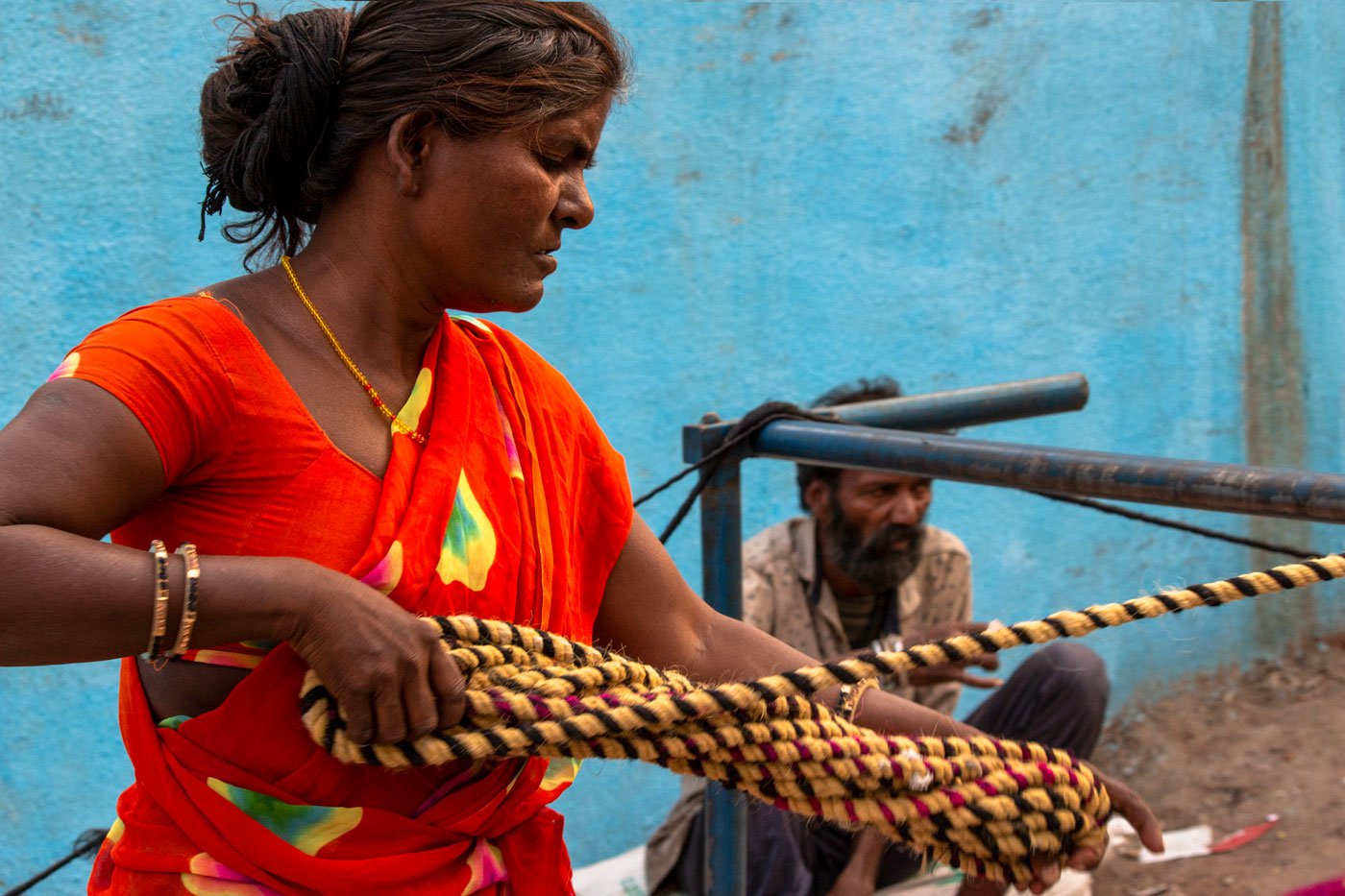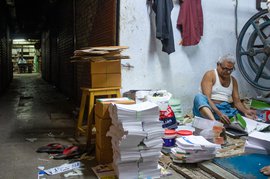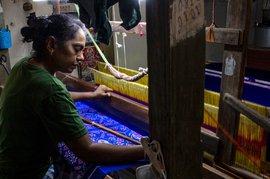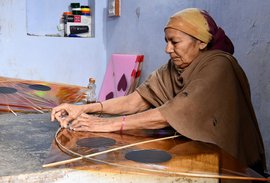“The train stops only for five minutes, and we board amidst a lot of rush and crowding. Sometimes the train starts moving, and we have to leave behind some bundles on the platform.” Saranga Rajbhoi is a rope maker, and the bundles she is forced to leave behind are leftover fibres from textile factories that women like her make into ropes they sell. The ropes are used to tie cows and buffaloes, cargo on trucks and tractors, and even to hang clothes to dry.
“ Hamara khaandani hai [Ours is a family business],” says Santra Rajbhoi. Seated in an open space near her home in a municipal housing block in Vatva, Ahmedabad, she is busy untangling knots from a heap of synthetic fibre.
Saranga and Santra belong to the Rajbhoi nomadic community in Gujarat. They travel from Ahmedabad to Surat buying up waste fibres from textile mills along the way, which they then turn into ropes. It’s a job that makes them leave home around eleven at night and return only at seven in the evening the next day. Their young children are left behind in the care of relatives and neighbours.
The trains they catch often reach their destination at one or two in the morning, so the women rope makers sleep on the railway platforms for which they are often harassed. “We are taken to the police station for two-three hours and questioned about where we come from. The policemen catch hold of poor people,” says Karuna. “If they feel like detaining us, they do.”
Karuna, Santra and Saranga are all neighbours in
the Char Maliya municipal housing located in Vatva. They say their homes lack
basic amenities like regular water supply and sewage lines. Electricity
connections came only after a long fight.


Santra Rajbhoi (left) belongs to the Rajbhoi nomadic community in Gujarat. Women in this community – including Saranga (seated) and Saalu – practice the traditional occupation of rope-making


Left: Karuna Rajbhoi and others twist strands of fibre into a rope. Right: Char Maliya building complex in Vatva, Ahmedabad, where the women live
They belong to the Rajbhoi community in which traditional occupations for women include making ropes whereas men work as ear-wax cleaners. Their community has been struggling for recognition and access to state benefits and a better standard of living. The Rajbhois are a nomadic tribe, but “our caste is not listed with the Nigam [Gujarat Nomadic and Denotified Tribes Development Corporation],” says Rajesh Rajbhoi, the mukhiya or head of the community. Accessing work opportunities and other schemes available for nomadic communities is not a straightforward process as, “we are listed there as ‘Bhoiraj’ instead of ‘Rajbhoi’ and that becomes a problem when it comes to government work.”
Neither Rajbhoi nor Bhoiraj figure in the list of 28 Nomadic Tribes and 12 Denotifed Tribes that appear on the Gujarat government’s website . ‘Bhoi’ of Gujarat are listed in the Draft list of Denotified Tribes, Nomadic Tribes and Semi-Nomadic Tribes of India (Ministry of Social Justice and Empowerment). In Gujarat, Bhoiraj are listed under Other Backward Classes. “People from our community are also called Salat-Ghera outside of Gujarat and are engaged in making mill-stones and grindstones,” says Rajesh. The Salat-Ghera are also a nomadic tribe and listed as such on the website.*****
Sourcing the fibre required to make ropes takes these women across textile factories in Surat. “Vatva to Maninagar and Maninagar to Kim. We buy the [raw] material at twenty-five rupees per kilo," says Saranga Rajbhoi, chewing a betel leaf. Her hands keep working on the fibres.
The distance from Maninagar in Ahmedabad to Kim in Surat is almost 230 kilometres. They have no other choice but to travel by train; fares are high, but a laughing Saranga, wiping the betel juice running down her chin, says, “We don’t buy tickets.” From Kim railway station the women travel by rickshaw to textile factories in the area.
“Any damaged material is kept aside. The workers
sell it to us or to the junk dealers, who in turn sell it to us,” says 47-year-old Gita Rajbhoi. But not just any fibre will do, explains Karuna: “Cotton is
of no use to us. We can only use
resam
[synthetic
silk], and the factories working with it are only in Kim.”


Left: Saranga (left) and Karuna (right) on a train from Maninagar to Nadiad. Right: Women take a night train to Nadiad forcing them to sleep on the railway platform from 12:30 a.m. until dawn


Left: The women have tea and snacks outside the railway station early next morning. Right: Karuna hauls up the bundles of rope she hopes to sell the following day
Often the raw material (fibre) is knotted together, says Gita and costs less. The price varies between Rs. 15 to 27 a kilo. White fibre used in sofas, bedding and pillows is expensive – Rs. 40 a kilo.
“One woman can bring 100 kilos. She might bring 25 or sometimes even 10 kilos,” says Santra. But there is no guarantee that they might get that much – there are always too many people looking to buy and not enough fibre to go around.
Transporting the material from Kim to Ahmedabad requires them to “go around [to multiple factories] in Kim to buy the goods and bring it to the station,” explains Saranga.
At the station, their large bundles attract the attention of the railway staff. “If they catch us, they sometimes let us go when we explain that we are poor. If some headstrong officer turns up, we have to pay 100-200 rupees,” adds Karuna Rajbhoi. “Every time we purchase material worth a thousand rupees, we end up spending three hundred [on travel].” Whether or not they are able to get the required material, an expense of Rs. 300 is inevitable.
A finished rope of 30 arms’ length is sold for Rs. 80 and a rope of 50 arms’ length for Rs. 100.
The women carry 40-50 ropes with them. Sometimes they manage to sell all and sometimes only about 20 in small towns and cities like Mahemdabad, Anand, Limbachi, Tarapur, Kathlal, Kheda, Govindpura, Matar, Changa, Palla, Gomtipur and many other places.


Left: Using one of the ropes, Karuna demonstrates how to tie a loop used to tether animals. Right: The women begin the day setting shop near a dairy; they hope to sell their ropes to cattle owners


Left: As the day progresses, Karuna and Saranga move on to look for customers in a market in Kheda district. Right: At Mahemdabad railway station in the evening, the women begin their journey back home
“We work hard to make the ropes and spend money to go and sell them in the villages of Nadiad and Kheda, only to be bargained down from 100 to 50-60 rupees,” says Saranga. And then the travel and fines also eat into their earnings.
Making ropes is hard and exhausting work that they do in between household chores. “ Jab nal aata hai tab uth jaate hain. [When water comes in the taps, we get up],” says Aruna Rajbhoi.
As their homes are too small to accommodate the work, the women work in the open with no protection from the sun. “We work from seven to noon, and from two to five-thirty in the afternoon,” she adds. “We make more ropes in the summer as the days are longer – about 20-25 in a day. But only 10-15 in the winter,” adds Rupa.
A small hand wheel and a large fixed spinning wheel are two important tools of their trade.
One woman spins the wheel while another holds
the strands, preventing them from sticking together. Yet another woman manages
the ends of the rope. Since three or four people are needed at a time, family
members often work together. “As we keep spinning the wheel, fibre gets spun
into yarn. Three separate strands are formed and get twisted together to form a
rope,” says Sarvila Rajbhoi, adding that a rope of 15-20 feet takes 30-45
minutes. In a day, a group can make 8-10 ropes, sometimes they even make
twenty. On order, they even make ropes 50-100 feet in length.
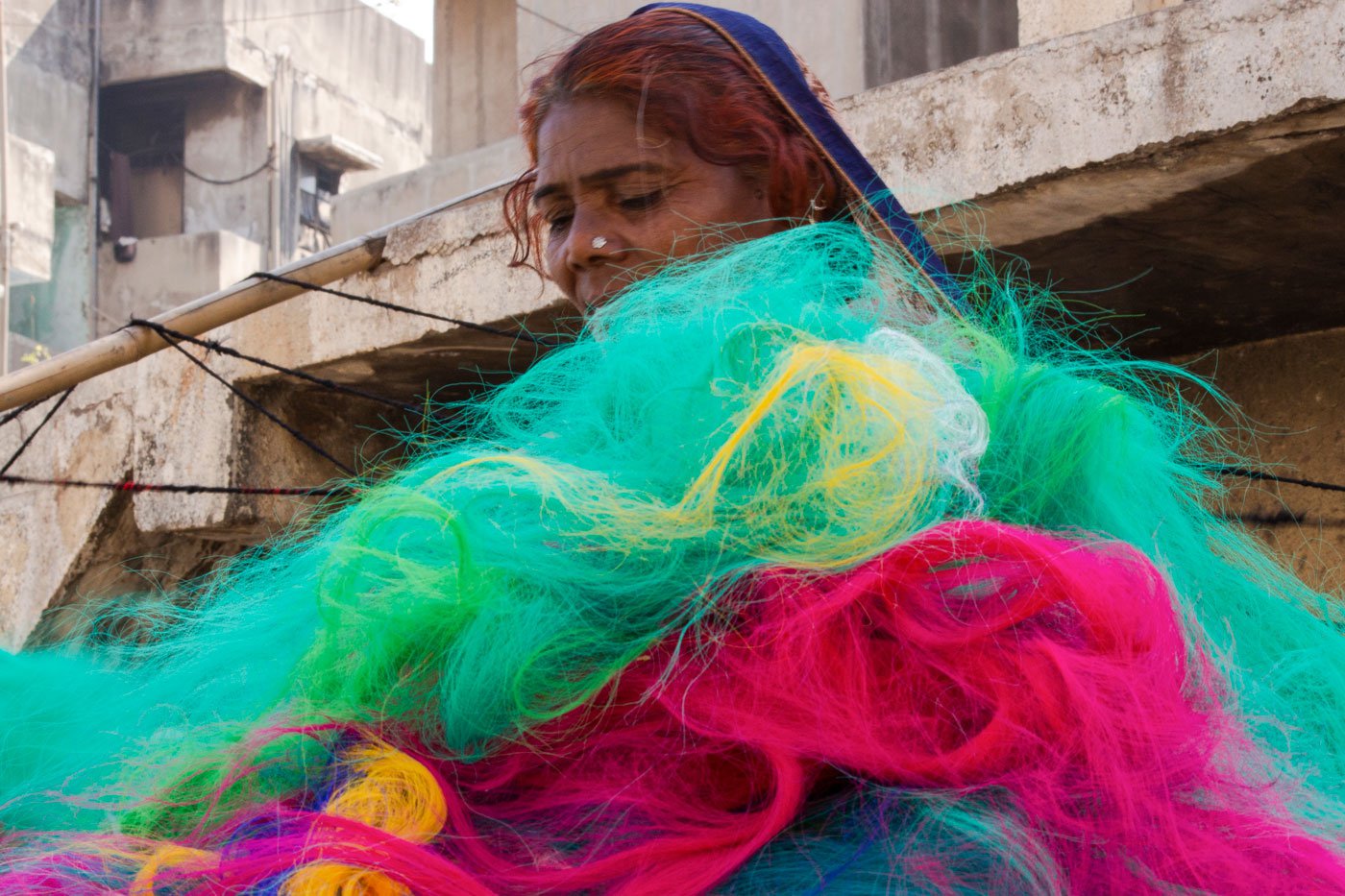

The Rajbhoi women buy a variety of discarded resam (synthetic) fibre from textile factories in Surat district and carry it back to Ahmedabad via train. The coloured fibre is cheaper and costs around Rs. 15 to 27 a kilo
The Bhoi community in the state are largely in the Saurashtra region. According to Bhagvadgomandal, an encyclopaedic Gujarati dictionary published in the 1940s, Bhois are "a backward Shudra community" once engaged in tanning leather. But opposition to animal slaughter from the dominant Jain community forced many of them to agriculture and other labour work. Bhois who turned to different occupations came to be known by different names. Rajbhois could have been palanquin bearers.
The women’s enterprise and hard work is brushed off by male members of the community, including Bhanu Rajbhoi. An ear cleaner by trade he says of the money the women earn: “It doesn’t help much. It just helps a little with their household expenses.” After all, caste-specific traditionally inherited occupations only beget “ thoda bahot ghar ka kharch.”
But to Gita Rajbhoi, this is still better than trying to find a salaried job. It is clear when she says, “ dasvin ke baad barvin, uske baad college, tab jaake naukri milti hai. Isse achha apna dhanda sambhalo ! [One has to pass Class 10, Class 12 and later college. Only then does one get a job. Better to manage your own business!]”.

Kajal (seated) and Rupa Rajbhoi untangle the collected fibre. Making ropes is exhausting work that the women do in between household chores

The process requires collective effort. One woman spins the wheel while another keeps the strands from getting tangled


A small hand wheel and a large fixed spinning wheel are two important tools of their trade

Rupa Rajbhoi attaches a length of twisted fibre to the larger spinning wheel

As their homes are too small to accommodate the work, the women work in the open with no protection from the sun

The women work from seven in the morning to five-thirty in the afternoon with a short break in between. They manage to make anywhere from 10-25 ropes in a day depending on the season

(From left to right) Saalu, Baby, Saranga and Bharti at work

The women’s hard work is often brushed off by male members of the community saying, ‘It just helps a little with their household expenses’

Although it doesn’t earn them a lot of money, some women consider having their own business easier than trying to look for a salaried job
The reporter would like to thank Aatish Indrekar Chhara.
